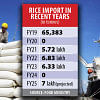IMF’s assessment and the real risks for Bangladesh’s economy

The International Monetary Fund (IMF) occasionally makes headlines in Bangladesh, the most recent being in June this year. But that already seems to have been long ago. And this is simply because the work they did at that time appears to have been overshadowed—to some extent, at least—by recent events.
It may be recalled that against the backdrop of multiple challenges (viz., balance-of-payment deficit, depletion of foreign exchange reserves, depreciation of the taka, and rising inflation) faced by the economy, the government went for the easy solution of a loan from the IMF. And a credit programme for $4.7 billion was agreed upon in January 2023. The loan, whose duration is 42 months, is to be disbursed in seven instalments—subject to satisfactory review by the agency. In June this year, the second review was successfully completed and the third tranche of $1.15 billion was released.
The loan, of course, came with conditionalities that include attaining a certain level of foreign exchange reserves (four months' imports), raising tax revenues, periodic adjustments in the prices of petroleum products and electricity, scrapping of the fixed interest rate regime, moving to market-determined exchange rate, etc.
As part of the second review of the credit programme, the IMF came up with a risk assessment for the economy in which nine risk factors, local and international, have been identified. Such assessments are useful even under normal circumstances. And when the going gets tough, it is more so. The assessment, therefore, is welcome.
However, given the multifarious challenges, the complexity of the situation, and expectations from a partner like the IMF, a few questions arise. What, for example, is the value of the exercise? Does it remain focused on the key issues and attach priority to them? How well do they address the key challenges faced by the economy? More importantly, have the real risks been identified and ways of addressing them explored? While some of such risks are structural (to be discussed presently), some come as unforeseen shocks—like the current situation—whose roots are also structural.
Interestingly, risk assessments of the kind done by the IMF are not usually done by the government, although it would have been desirable to have a homegrown exercise reflecting the national context and priorities more closely.
To be useful, a review of challenges and risks faced by the economy would have to be cast against their genesis and evolution. It is by now well-known that wrong policies were pursued for several years in the areas of exchange rate determination and interest rates. They helped keep imports as well as capital cheap. Exporters were compensated in various ways. Credit at a low rate of interest encouraged capital flight. Uncertainty in the business environment led exporters to park their export earnings abroad.
Not only were wrong policies pursued, necessary corrective measures—and some half-hearted—were adopted with considerable delays. Even now, the uncertainty in the policy environment has not been overcome completely.
The situation was compounded by political economy forces and interests of influential groups. Valuable time was lost in 2023 in the run-up to the national election. Even after that, concrete steps to reform exchange rate determination were taken only in May 2024. The real risk for the economy lies in such policy inertia of the government and continuation of protection for its cronies. Add to that the possibility of sudden shocks from unforeseen events.
For the economy to come out of the current abyss and for growth to turn around, the crisis of confidence will need to be overcome and basic conditions for growth restored urgently. And for that to happen, the foreign exchange reserves will have to start rising, which, in turn, would depend critically on not just export flows but also on prompt and full return of the export proceeds and normal flow of remittances. Only then will the regime of import compression give way to normal business and growth. That is also needed to fight inflation, which is an issue of immense concern.
The rate of inflation has been rising steadily since 2021, and the annual inflation rate has been hovering near a double digit figure for some time. Inflation can be caused by a variety of factors operating from demand and supply sides, and Bangladesh is no exception. In fact, the recent IMF review of the economy (June 2024) acknowledges this and estimates that half of the recent price increases can be attributed to the "pass through" effect of exchange rate depreciation. And yet, the organisation recommends monetary tightening as the measure needed for fighting inflation.
The Bangladesh Bank has abandoned the policy of fixed interest rates—even though the decision came later than warranted. It started a policy of monetary tightening in 2023 and is continuing that stance. But that does not seem to be producing the desired effect on the inflation rate. The proponents of this approach are mentioning the delay in the adoption of this policy as a reason for its ineffectiveness, and are suggesting further tightening. Under the loud chorus produced by this group of policy analysts and the international backers of the approach, voices for pragmatic solutions to the problem are getting drowned. We are forgetting that even economists like Olivier Blanchard and Ben Bernanke are attributing inflation to both demand and supply side factors.
In Bangladesh, it has of late become customary to cite other countries and say that they have succeeded in containing inflation by raising the policy rate and Bangladesh has not because of not using the instrument at the right time. While doing so, we forget that one size does not fit all. Among the major developed countries, for example, the success the US has achieved is not matched by countries of Europe and the UK. Also, the latter have not been able to avoid slowdown in their economies and recession in the process. Even in the case of the US, the extent to which monetary policy has contributed to the success in fighting inflation is being debated by researchers. In India, although the policy rate has been raised substantially in 2022 and 2023, it did not have an adverse effect on credit growth because of a variety of factors.
While dealing with macroeconomic issues of immediate importance, major structural issues like employment—especially jobs for the youth and first-time job-seekers, and livelihoods of the low-income people have either been ignored or relegated to the category of "also." The potential risk from such a narrow focus has been ignored by the external agencies as well as by the government. And when issues come to a fore, the usual response is to bury them under the refrain of "destructive forces." The danger of doing so is illustrated by the shock inflicted on the economy by the current situation.
Unfortunately, the Bangladesh government has never come up with a clear thinking on either the macroeconomic issues like inflation, or on jobs and livelihoods of the poor and low-income people and approaches to fighting such evils. The real risks here are continued dependence on (or adoption of) "policy advice" from outside, adoption of half-hearted and one-sided measures, ignoring the potential shocks arising out of deeper discontent, and the lack of a clear and coherent approach on the part of the government.
Dr Rizwanul Islam is an economist and former special adviser to the Employment Sector, International Labour Office, Geneva.
Views expressed in this article are the author's own.
Follow The Daily Star Opinion on Facebook for the latest opinions, commentaries and analyses by experts and professionals. To contribute your article or letter to The Daily Star Opinion, see our guidelines for submission.

 For all latest news, follow The Daily Star's Google News channel.
For all latest news, follow The Daily Star's Google News channel. 











Comments